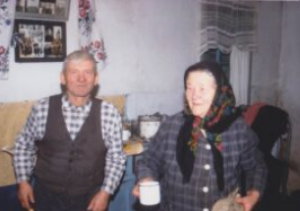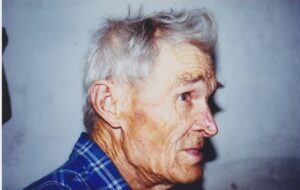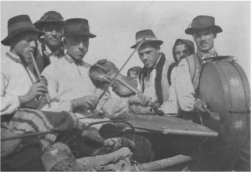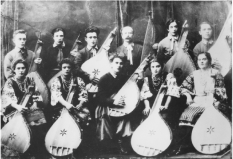Anastasia Yukhymivna Tkachenko (Cherkasy region)
—What did your father do in the farmstead before the kolhosp? Did you own land?
Anastasia Yukhymivna: We didn’t have much land. My father had a large family, many sons, so they divided the land between themselves little by little. We weren’t rich. We had about 1.5 or two hectares.
Anastasia Yukhymivna Tkachenko (Cherkasy region)
—What kind of work did your father do and what did your mother do?
Anastasia Yukhymivna: They both sowed and plowed together and helped each other.
—Who cooked?
Anastasia Yukhymivna: My mother.
—Who took care of the cattle?
Anastasia Yukhymivna: Both of them. We had a cow, a horse, hens, and pigs. We were building a house.
Anastasia Yukhymivna Tkachenko (Cherkasy region)
—When the kolhospy were organized, who was in charge in the village?
Anastasia Yukhymivna: The head of the village council and the brigade chief were elected.
—How were they elected?
Anastasia Yukhymivna: At the assembly. A skhodka would take place. There were several brigades; the population was large in Ivkivtsi at the time.
—What were the neighborhoods in your village?
Anastasia Yukhymivna: Kerekivka, Kotsarivka, Bondarivka (my village now), Shlioncharivka, Varchankivka, Shpakivka, Tymoshivka, Koshovivka, and Buriachkivka. People’s last names were different.
—During the kolhosp times, were those neighborhoods called brigades?
Anastasia Yukhymivna: No, our brigade No. 1 was here: Korobkivka, Zozulivka, and Kerekivka. We had a mighty brigade.
—How many neighborhoods (kutky) were in one brigade: three, four, or five?
Anastasia Yukhymivna: I don’t know, more than that. There was a garden brigade and a field brigade. The garden one used to plant vegetables and fruit, and the field one would take care of the wheat, corn, and potatoes. We had three or four brigades, I don’t remember, but we had many women workers. Harvest time was great: the haymakers would come with the reapers; we’d come to the kolhosp and then go to the steppes, each with their brigade. There were the haymakers and the women who sheaved. The children would walk around gathering the spikelets.
Anastasia Yukhymivna Tkachenko (Cherkasy region)
—Was there a church before the collectivization?
Anastasia Yukhymivna: There was, and a famous one! It was made of wood and known to have the best decorations.
—What was it called?
Anastasia Yukhymivna: Pokrova [Intercession].
—Who was the priest?
Anastasia Yukhymivna: Yavorsky. I can’t remember his first name. His son Kostantin Yavorsky goes by Yavorovsky now. He also had daughters Lisa and Ira. Lisa and I were the same age.
—What role did the priest play in the village? Did he have authority? Did he own land in the fields?
Anastasia Yukhymivna: He didn’t have much land. I know he used to administer services in the apartments. They lived near the school; this garden used to be theirs. People call it “the priest’s garden.”
—After the kolhosp started, what did he do?
Anastasia Yukhymivna: At the time, the church was closed and dismantled, and they built a school.
—Who dismantled the church?
Anastasia Yukhymivna: I don’t know. It was a monastery, and in 1935 it was dismantled, probably.
—What about the church—was it dismantled in 1930 or 1932?
Anastasia Yukhymivna: In 1930, but I can’t say for sure. I was little. We’d run around there. I kept an altar lamp from the church.
—How did you get it?
Anastasia Yukhymivna: Well, they broke everything, and we were running around. There were icons, too. I had one of Serafym Sarosky [St. Seraphim of Sarov]. It was damaged by the clothing moth, and I was told to burn it. Now I’m so sorry I did.
—What did you do with the ashes?
Anastasia Yukhymivna: I took them to the field; that’s it.
Anastasia Yukhymivna Tkachenko (Cherkasy region)
—When there was a priest, the funeral was held with a priest and a keener. What were the funerals like after the churches were closed down?
Anastasia Yukhymivna: They were the same funerals. People would invite a keener; the women would come to keen.
—Did the women sing and read the psalms?
Anastasia Yukhymivna: Yes.
—Did they read the psalms inside or outside?
Anastasia Yukhymivna: Inside, near the body. I’m thinking of my sister’s and my uncle’s wife’s funerals. A woman would come and read the Book of Psalms all day long and all night long, until the end of the book. Then a pivcha would come. If there weren’t any pivchi, women who could sing would come by themselves and sing in the house.
—Was the singing allowed on the way to the cemetery?
Anastasia Yukhymivna: No.
—Was it forbidden by the members of the party?
Anastasia Yukhymivna: I don’t know who forbade it, but people said it was not allowed.
—Were the women singers paid?
Anastasia Yukhymivna: No, why? Back in the day, people didn’t pay, but now it’s all on case-by-case basis. People would prepare a dinner back in the day, and then later on dinners got more abundant, with fish and meat.
Anastasia Yukhymivna Tkachenko (Cherkasy region)
—Where did you buy the icons for your wedding day?
Anastasia Yukhymivna: We already had them.
—What were they called?
Anastasia Yukhymivna: Mother’s Benediction.
—Where did your mother get them?
Anastasia Yukhymivna: She bought them.
—Was there an icon painter in your village?
Anastasia Yukhymivna: Yes; he was called a bohomaz.
—Does he have a son or a daughter?
Anastasia Yukhymivna: He has a son, but he lives somewhere far. The bohomaz’s name was Yakiv.
—Did he paint for the church?
Anastasia Yukhymivna: Both for the church and for individuals, if they commissioned icons. The icons were treated as the old ones.
—Where did he sell the icons: did the people go to his place to buy them or did he take them to a bazaar?
Anastasia Yukhymivna: No, someone else would take them to the bazaar.
—How was he paid?
Anastasia Yukhymivna: With money.
—How many icons did your parents usually have in the house?
Anastasia Yukhymivna: As many as they wanted.
Anastasia Yukhymivna Tkachenko (Cherkasy region)
—What were the names of the neighborhoods [kutky] in your village?
Anastasia Yukhymivna: Kerekivka, Kotsarivka, and Bondarivka. Bondarivka now is a village and my neighborhood. Others were Shlionchakivka, Varchankivka, Shpakivka, Tymoshivka, Koshovivka, and Buriachkivka. The last names were different.
—After the kolhospy were set up, did these names change to brigades?
Anastasia Yukhymivna: No, our first brigade was here: Korobivka, Zozulivka, and Kerekivka. We had a strong brigade.
—How many neighborhoods were in one brigade: three, four, or five?
Anastasia Yukhymivna: I don’t know, more than that. There was a garden brigade and a field brigade. The garden one used to plant vegetables and fruit, and the field one would take care of the wheat, corn, and potatoes. We had three or four brigades, I don’t remember, but we had many women workers. The harvest time was great: the haymakers would bring their scythes. We’d come to the kolhosp and then go to the steppes, each with its brigade. There were the haymakers and the women who sheaved. The children would walk around gathering the spikelets.
Anastasia Yukhymivna Tkachenko (Cherkasy region)
—When you were a young girl, did you sing in your neighborhood [kutok] or did you go to your neighbors [a neighboring kutok]?
Anastasia Yukhymivna: Why would I go to the neighbors? I sang in my neighborhood [kutok].
—Did guys come from nearby neighborhoods [kutky]?
Anastasia Yukhymivna: Yes, from Vedmedivka and elsewhere. I played and so did my brother and sister. We had a balalaika, a guitar, and a mandolin. I played bubon very well.
—When did you play—at the vechornytsi?
Anastasia Yukhymivna: We’d work all day long. In the evening we’d go to wash up in a pond, change, and go to the streets. People would gather in every street: Korobkivka, Kotsarivka, or Kerekivka and on they would go singing. Farther on, we had a small wooden club. People would come in and sing with great joy. We were hungry, but there was joy.
—What did you play?
Anastasia Yukhymivna: Krakowiak, polka, hopak, korobeiniki—everything, everything, everything.
—You would play instruments and people would dance, right?
Anastasia Yukhymivna: Right.
—Did someone play the fiddle, too?
Anastasia Yukhymivna: We had a teacher Oleksandra Ivanivna Posobilova. She is still alive. She played the fiddle.
—When was she born?
Anastasia Yukhymivna: She was born in 1917. Marko played, too, and he was also born in 1917.
—Is Marko still alive?
Anastasia Yukhymivna: Yes, both of them are.
—How did you play?
Anastasia Yukhymivna: We played in the club. We’d sit down near the stage and play.
—How were you paid?
Anastasia Yukhymivna: For what? We played for ourselves. When we sang in the club, we raised the roof. Each group sang their songs. Some singers competed to draw the guys closer to themselves.
—Where did you buy your balalaika?
Anastasia Yukhymivna: Balalaikas were sold in stores in Vedmedivka and Ivkivtsi. They also sold guitars and mandolins.
—A balalaika, a guitar, and a mandolin?
Anastasia Yukhymivna: And a bubon, too. This was before and after the war.
—Was the bubon small?
Anastasia Yukhymivna: It was round.
…………………………………………………………………………………
—Was there a tavern in your village?
Anastasia Yukhymivna: There may have been one during my parents’ time, I don’t know. There was a store.
—Was there a director in the club?
Anastasia Yukhymivna: Yes, Posobilova. Then she left, and Myfodii Osypovych Fylonenko was the director.
Anastasia Yukhymivna Tkachenko (Cherkasy region)
—Where would you buy a balalaika?
Anastasia Yukhymivna: They were sold in the stores in Vedmedivka and Ivkivtsi. There were also guitars and mandolins for sale.
—A balalaika, a mandolin, and a guitar?
Anastasia Yukhymivna: And bubon, too. This was before and after the war.
—What was the bubon like? Was it small?
Anastasia Yukhymivna: It was round.





